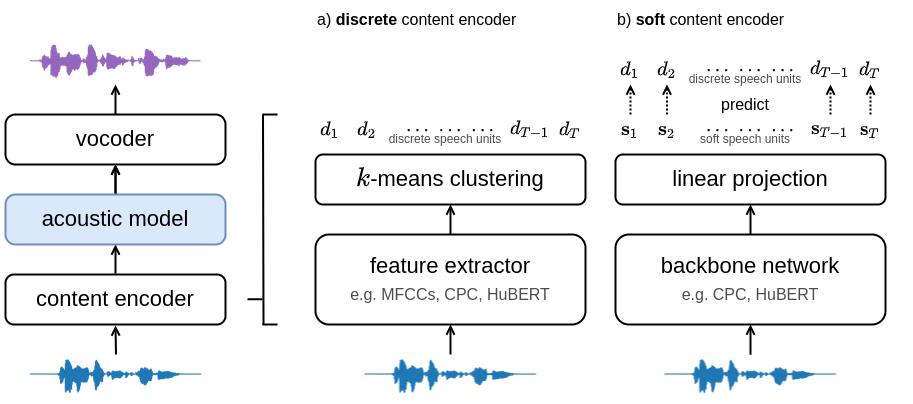Training and inference scripts for the acoustic models in A Comparison of Discrete and Soft Speech Units for Improved Voice Conversion. For more details see soft-vc. Audio samples can be found here. Colab demo can be found here.
import torch
import numpy as np
# Load checkpoint (either hubert_soft or hubert_discrete)
acoustic = torch.hub.load("bshall/acoustic-model:main", "hubert_soft").cuda()
# Load speech units
units = torch.from_numpy(np.load("path/to/units"))
# Generate mel-spectrogram
mel = acoustic.generate(units)usage: generate.py [-h] {soft,discrete} in-dir out-dir
Generate spectrograms from input speech units (discrete or soft).
positional arguments:
{soft,discrete} available models (HuBERT-Soft or HuBERT-Discrete)
in-dir path to the dataset directory.
out-dir path to the output directory.
optional arguments:
-h, --help show this help message and exit
Download and extract the LJSpeech dataset. The training script expects the following tree structure for the dataset directory:
└───wavs
├───dev
│ ├───LJ001-0001.wav
│ ├───...
│ └───LJ050-0278.wav
└───train
├───LJ002-0332.wav
├───...
└───LJ047-0007.wav
The train and dev directories should contain the training and validation splits respectively. The splits used for the paper can be found here.
Extract mel-spectrograms using the mel.py script:
usage: mels.py [-h] in-dir out-dir
Extract mel-spectrograms for an audio dataset.
positional arguments:
in-dir path to the dataset directory.
out-dir path to the output directory.
optional arguments:
-h, --help show this help message and exit
for example:
python mel.py path/to/LJSpeech-1.1/wavs path/to/LJSpeech-1.1/mels
At this point the directory tree should look like:
├───mels
│ ├───...
└───wavs
├───...
Use the HuBERT-Soft or HuBERT-Discrete content encoders to extract speech units. First clone the content encoder repo and then run encode.py (see the repo for details):
usage: encode.py [-h] [--extension EXTENSION] {soft,discrete} in-dir out-dir
Encode an audio dataset.
positional arguments:
{soft,discrete} available models (HuBERT-Soft or HuBERT-Discrete)
in-dir path to the dataset directory.
out-dir path to the output directory.
optional arguments:
-h, --help show this help message and exit
--extension EXTENSION
extension of the audio files (defaults to .flac).
for example:
python encode.py soft path/to/LJSpeech-1.1/wavs path/to/LJSpeech-1.1/soft --extension .wav
At this point the directory tree should look like:
├───mels
│ ├───...
├───soft/discrete
│ ├───...
└───wavs
├───...
usage: train.py [-h] [--resume RESUME] [--discrete] dataset-dir checkpoint-dir
Train the acoustic model.
positional arguments:
dataset-dir path to the data directory.
checkpoint-dir path to the checkpoint directory.
optional arguments:
-h, --help show this help message and exit
--resume RESUME path to the checkpoint to resume from.
--discrete Use discrete units.
If you found this work helpful please consider citing our paper:
@inproceedings{
soft-vc-2022,
author={van Niekerk, Benjamin and Carbonneau, Marc-André and Zaïdi, Julian and Baas, Matthew and Seuté, Hugo and Kamper, Herman},
booktitle={ICASSP},
title={A Comparison of Discrete and Soft Speech Units for Improved Voice Conversion},
year={2022}
}
[] Hirokazu Kameoka, Takuhiro Kaneko, Kou Tanaka, and Nobukatsu Hojo, “Stargan-vc: Non-parallel many-tomany voice conversion using star generative adversarial networks,” in SLT, 2018.
idea ====> By using the parallel method, it is possible to identify each person's voice completely separately in a conversation two by two.
[] Adam Polyak et al., “Speech resynthesis from discrete disentangled self-supervised representations,” in Interspeech, 2021.
idea ====> The system automatically combines multiple conversations and uses artificial intelligence to obtain a unique output from the combination of multiple conversations.
[] Aaron van den Oord, Yazhe Li, and Oriol Vinyals, “Representation learning with contrastive predictive coding,” arXiv preprint arXiv:1807.03748, 2018. [] Tu Anh Nguyen et al., “The zero resource speech benchmark 2021: Metrics and baselines for unsupervised spoken language modeling,” in NeurIPS SAS Workshop, 2020.
idea ====> An artificial intelligence that has the ability to convert words, images and 3D text to each other.
[20] Julian Za¨ıdi, Hugo Seute, Benjamin van Niekerk, and ´Marc-Andre Carbonneau, “Daft-exprt: Robust prosody ´transfer across speakers for expressive speech synthesis,” arXiv preprint arXiv:2108.02271, 2021.
idea ====> The speaker (tone) can distinguish between strong and weak sound. Make the louder text bigger and the weaker text thinner. Recognize different sounds that have different wavelengths in a speech.
[] Tomoki Toda, Alan W Black, and Keiichi Tokuda, “Voice conversion based on maximum-likelihood estimation of spectral parameter trajectory,” TASLP, vol. 15, no. 8, 2007.
[] Kou Tanaka, Hirokazu Kameoka, Takuhiro Kaneko, and Nobukatsu Hojo, “Atts2s-VC: Sequence-to-sequence voice conversion with attention and context preservation mechanisms,” in ICASSP, 2019.
[] Lifa Sun, Kun Li, Hao Wang, Shiyin Kang, and Helen Meng, “Phonetic posteriorgrams for many-to-one voice conversion without parallel data training,” in ICME, 2016.
[] Wen-Chin Huang, Tomoki Hayashi, Shinji Watanabe, and Tomoki Toda, “The Sequence-to-Sequence Baseline for the Voice Conversion Challenge 2020: Cascading ASR and TTS,” in Interspeech BC/VCC workshop, 2020.
[] Hirokazu Kameoka, Takuhiro Kaneko, Kou Tanaka, and Nobukatsu Hojo, “Stargan-vc: Non-parallel many-tomany voice conversion using star generative adversarial networks,” in SLT, 2018.
[] Kaizhi Qian, Yang Zhang, Shiyu Chang, Xuesong Yang, and Mark Hasegawa-Johnson, “AutoVC: Zero-shot voice style transfer with only autoencoder loss,” in ICML, 2019.
[] Yi Zhao et al., “Voice conversion challenge 2020: Intralingual semi-parallel and cross-lingual voice conversion,” in Interspeech BC/VCC workshop, 2020.
[] Adam Polyak et al., “Speech resynthesis from discrete disentangled self-supervised representations,” in Interspeech, 2021.
[] Benjamin van Niekerk, Leanne Nortje, and Herman Kamper, “Vector-quantized neural networks for acoustic unit discovery in the zerospeech 2020 challenge,” in Interspeech, 2020.
[] Wen-Chin Huang, Yi-Chiao Wu, and Tomoki Hayashi, “Any-to-one sequence-to-sequence voice conversion using self-supervised discrete speech representations,” in ICASSP, 2021.
[] Wei-Ning Hsu et al., “Hubert: Self-supervised speech representation learning by masked prediction of hidden units,” arXiv preprint arXiv:2106.07447, 2021.
[] Jan van Gemert, Cor J. Veenman, Arnold W. M. Smeulders, and Jan-Mark Geusebroek, “Visual Word Ambiguity,” TPAMI, vol. 32, no. 7, 2010.
[] Tu Anh Nguyen et al., “The zero resource speech benchmark 2021: Metrics and baselines for unsupervised spoken language modeling,” in NeurIPS SAS Workshop, 2020.
[] Benjamin van Niekerk, Leanne Nortje, Matthew Baas, and Herman Kamper, “Analyzing speaker information in self-supervised models to improve zero-resource speech processing,” in Interspeech, 2021.
[] Shu wen Yang et al., “Superb: Speech processing universal performance benchmark,” in Interspeech, 2021.
vahid sepehrian oloom tahghighat 40012340048013
